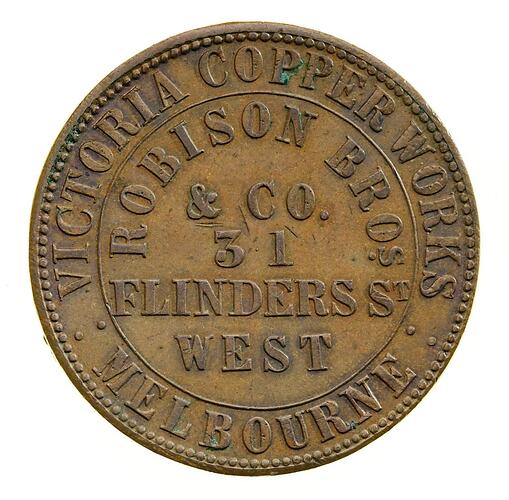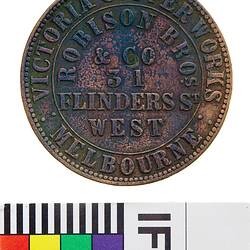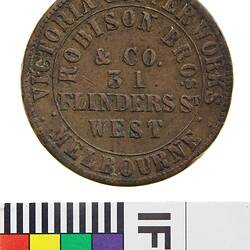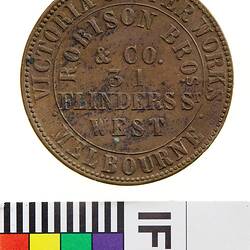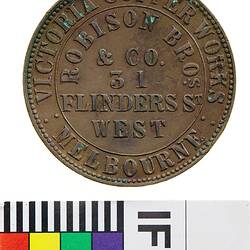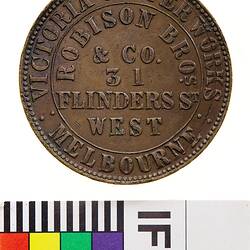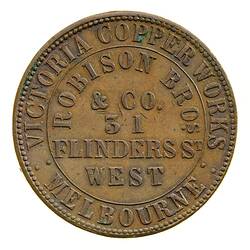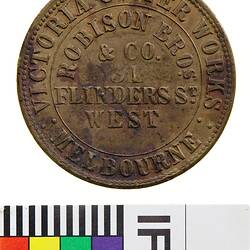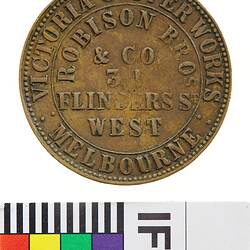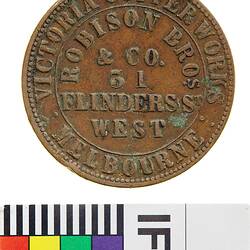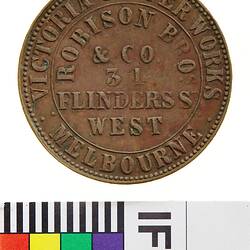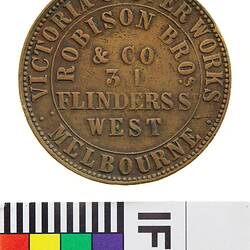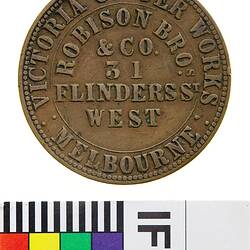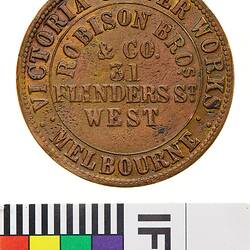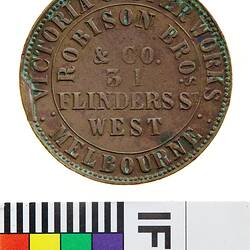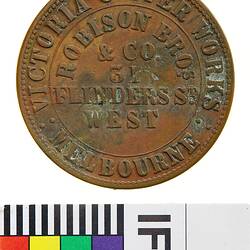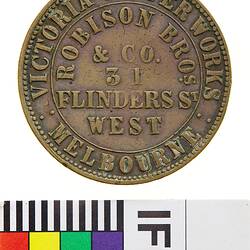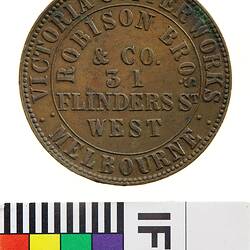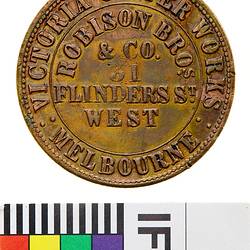Robison Bros issued 4 penny tokens, all in 1862.
James McFarlane Robison and Thomas Buchanan Campbell Robison came to Melbourne from Leith in Scotland. In 1854 they entered into partnership with Henry Dodds, also a Scot and founded this company at 103 Flinders Street West (Gardner). Research by Museum Victoria volunteer John Hope shows that their premises actually faced Royal Highlander Lane, off Flinders Street. Their listing in Melbourne Directories provide a different sequence of events:
1855: Robison, W. & G., Coppersmiths, Braziers and Plumbers, 103 Flinders Street West.
1856: Robison Brothers & Co, Coppersmiths, Braziers and Plumbers, 99 and 103 Flinders Street West.
1857: (Robison, William; Robison, James M.) Coppersmiths and Plumbers, 113 Flinders Street West
1858: No Robison Brothers, however: Robison, William, Coppersmith and Plumber 113 Flinders Street West
1859: Robison Brothers & Co., Coppersmiths and Plumbers, 8 Flinders Lane East
1860: Robison Brothers, Coppersmiths and Braziers, 11 Bond Street
1861: Robison Brothers, Coppersmiths and Braziers, 91 Flinders Street West
1862: Robison Brothers, Coppersmiths and Braziers, 91 Flinders Street West
1863-1868: Robison Brothers (Jared, Andrew, J.M., Thos. B.C., Foster, George), Coppersmiths and Braziers, 31 Flinders Street West
1869: Robison Brothers, Coppersmiths and Braziers, 31 Flinders Street West & Bond Street
1870: Robison Brothers (Jared, Andrew, J.M., Thos. B.C., Foster, George; Dodds, Hy.), Coppersmiths and Braziers, 31 Flinders Street West, Bond Street and Yarra Bank South.
It would appear from these listings that William and George Robison founded the company in 1854 (in time to be listed in the 1855 directory) and that their brothers joined them over the next nine years. John Hope's research indicates that James McFarlane Robison was also involved in establishing the company. William Robison, one of the founders of the company, left in 1858 to begin his own, competing business.
Both Robison Brothers & Co., and William Robison advertised extensively during the 1850s and 1860s. In 1857 and 1858, both businesses took out quarter page advertisements in the Sands and Kenny Directories, advertising their stock and their work fitting and maintaining these products: 'Copper Boilers, Stills, Confection Pans, Soda Water Cylinders, Lift and Force Pumps, and every other Article in the above branches, manufactured. Steam Boat and Distillery work executed with dispatch by experienced workmen. Always on hand, a large supply of Sheet Copper and Brass, Copper Bottoms, Copper Boilers, Copper Rivets and Washers, Sheet Lead, Lead Piping, Block Tin, Steam Cocks, Lift and Force pumps.'
William Robison's departure from the family business is made clear from an advertisement published on the front page of Melbourne's The Herald, July 2, 1858. It read 'Copper Work Made and Repaired by William Robison, 113 Flinders street west (principal of the late firm of Robison Brothers & Co.).' From the fact that Robison Brothers are referred to as 'the late firm,' it seems possible that William's departure was assoicated with a lapse in the company's activities. In 1859 he placed his own advertisement in Sands and Kenny's directory, describing the same range of goods and services as in the previous year's advertisement, but adding the comment that 'W.R. begs to call the attention of those about to establish themselves in the brewing or distilling business to the fact that he has had 20 years' practical experience in the above Branches, and is well acquainted with the most improved systems now in use, so that Parties favouring him with orders, may rely that their work will be effectually done, and also cheaper than any other House in these Colonies.' He ran similar advertisements in directories through the 1860s.
By 1862 the main family firm was listed at 31 Flinders Street, the address from which they issued their tokens (a move that was reflected in the listings in Sands and McDougall's directory for the following year). According to Gardner, in the years after 1870 they moved again to an address then known as Moray Street, Emerald Hill (now (2005) Queens Bridge Road, South Melbourne), and then to two sites in Lormier and Normanby Roads in South Melbourne. The company was still working from these sites when Gardner's biography appeared in 1912 and he notes that the business was growing strongly.
Once established in South Melbourne the business again expanded, and in addition to their metal working business, Robison Bros. developed a substantial ships chandler's business. They remained at their South Melbourne site (approximately where the Melbourne Exhibition Centre stands in 2005) until 1971.
The business suffered greatly, according to notes from the University of Melbourne Archives, during the crash of the early 1890s, but survived in a reduced form. In 1907 Robison Bros. & Co. became a proprietary company in the hands of the descendants of the founders. It went into receivership during the great depression, being bought out by 'Valentine Henderson of Henderson's Federal Spring Works' in 1935. The company operated as Robison Bros. and Co. Pty Ltd until 1973. Papers of the business, mostly concerning the period 1890-1930, are held by the Melbourne University Archives.
Mr. Dodd, who was listed as a partner in the firm in 1870, seems to have been the only member of the company to have entered public life, serving as a councillor for South Melbourne in 1882-1883 and its Mayor in 1884.
Research undertaken by Museum Victoria volunteer John Hope demonstrates the breadth of metal working and other enterprises in which Robison Bros. were involved:
'Throughout their history Robison's played a significant role in the development of Melbourne and Victoria. Among many of their projects were the installation of security bars at Pentridge Goal, the Dight's Falls pumping station to supply water to Albert Park Lake via the botanical gardens, the first successful refrigeration plant to ship frozen meat to England, manufacture of brewing vats, bitumen tankers, diving helmets and gun carriages.
They also built railway connection between Spencer Street and Flinders Street. They installed the first electric butt welding equipment in Victoria.
Interestingly, Robison's produced the spun-cast hollow cast-iron milestones installed across large areas of the Western District of Victoria indicating (in many instances) every half-mile of distances between then tiny townships such as Mortlake and Darlington. A few of these are now cherished as enduring collector's items.'
Their tokens were struck by Thomas Stokes in 1862.
References:
Gardner, F. (1912). 'Trade tokens and the firms who issued them', The Australian Storekeepers and Traders Journal, 1912, p.9.
Sharples, J. (1993). 'Catalogue of Victorian Trade Tokens.' Journal of the Numismatic Association of Australia. Vol. 7. December, pp.55-56.
University of Melbourne Archives. Acc. No. 73/32. Robison Brothers & Co. Pty. Ltd.
SLV directories collection 1851-1870.
Advertisement. Sands and Kenny's Commercial and General Melbourne Directory for 1857. Advertisements section: p.57
Advertisement. Sands and Kenny's Commercial and General Melbourne Directory for 1858. Advertisements section: unnumbered page
Advertisement. The Herald. 2 July 1858; p.1.
Advertisement. Sands and Kenny's Commercial and General Melbourne Directory for 1859. Advertisements section: p.31
Advertisement. Sands and McDougall's Commercial and General Melbourne Directory for 1857. Advertisements section: p.44
Hope, John 'History of Robison Bros', unpublished MSS, 3 pps.
More Information
-
Keywords
-
Localities
-
Authors
-
Contributors
-
Article types
